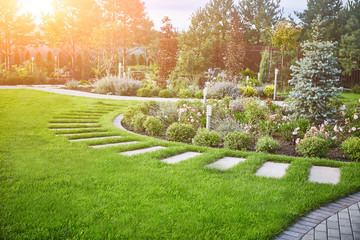Landscape Designers create gardens that match their client’s aesthetic and functional needs. Design elements like color, form, and texture create a pleasing and attractive landscape. Landscapers study how clients use the space and how much time they spend there. They also study the site and its conditions to determine how plants will grow.

Creativity is the ability to develop new ideas, connections, and solutions. It is an essential part of human nature and helps us to spark joy, foster resilience, and encourage self-actualization. It’s an important skill for a Landscape Designer to possess. They need to be able to come up with creative ideas and implement them on a project.
Several factors can influence creativity: personality traits, environmental conditions, and other variables. However, it’s also important to remember that creativity is a learned skill. Researchers have studied creativity in many disciplines, including psychology and business studies. It has been linked to general intelligence, personality traits and mental and neural processes.
The technical skills a Landscape Designer needs include horticulture, soil science, turf grass, and plant science knowledge. They also need to be able to use computer-aided design (CAD) and software to produce professional-looking designs for their clients.
For example, they may create plans for patios and walkways that consider the type of soil, sun exposure and nearby bodies of water. This is a crucial part of their job because it ensures that the finished outdoor space will be functional and attractive.
In addition to technical skills, a Landscape Designer needs to be creative and think independently to turn their ideas into reality. They must also possess excellent communication and organizational skills to work effectively with clients, contractors, vendors and suppliers.
Communication is an important skill for a Landscape Designer. This is because they must be able to explain their plans to clients and other people involved in the project. They must also be able to collaborate with others to ensure that their design ideas are executed properly. Problem-solving skills are another soft skill that US landscape designers need to have. This is because they often work on projects with unexpected challenges and may need to think quickly to develop creative solutions.
Time management is another important soft skill for a US landscape designer. This is because they need to be able to plan for the amount of work that each project requires and create realistic deadlines for its completion. The main requirements for a job as a Landscape Designer are usually listed on employer job listings and in resumes from people who’ve held this position. These include Communication Skills, Innovation, Outdoor, Detail Oriented and Collaboration.
Landscape designers work to create outdoor spaces for a range of clients. These include homeowners, business owners and schools. They design gardens, landscapes, and playgrounds. They also help people plan the layout of their homes, roads, and parking areas. To succeed as a Landscape Designer, you must have good business skills. These combine the ability to think creatively and critically, communicate professionally, make ethical business decisions, and work globally.
Learning how to use computer-aided design (CAD) programs for your designs would be best. This will help you create more precise plans and work faster. To gain experience and build your portfolio, try volunteering or interning with a landscaping company or organization. This will give you a taste of the work involved and could help you land your first job as a Landscape Designer.
Landscapers maintain the outdoor space of buildings, parks, and public spaces. They may do it by themselves or in conjunction with a team of construction experts. You can also find them working on golf courses and amusement parks. The landscape industry is vast and varied. Many career specialists play a role in it. For instance, agronomists work with soil science. And arborists work with tree planting.
Typically, landscaping jobs involve a lot of manual labor, lifting, and climbing. This isn’t to say that the job is boring. However, it can be unsafe. Thankfully, there are a few tips and tricks to making the most of your new position. Taking the time to learn how to dress for the job is a smart move. A nice shirt and pants can go a long way in the workplace. It’s also important to be able to work under pressure. Those who do not do so risk injury.